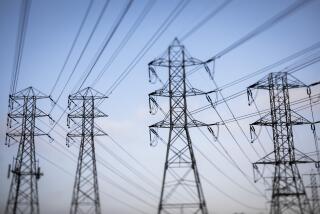The best way to replace San Onofre’s power
Two years after the San Onofre nuclear plant was shuttered because of its problematic steam generators, state authorities are deciding how Southern California Edison ought to power the homes and businesses of its customers without the troubled plant, which generated 19% of the company’s energy.
Finding the right answer is especially important because, for all the dangers of nuclear power, it has the advantage of a low carbon footprint. Natural gas, the easiest replacement, is a fossil fuel that worsens global warming. Yet just this week, the state Air Resources Board released an advisory saying that the state must redouble efforts to reduce its reliance on such fuels if it is to reach its carbon reduction goals by 2050.
Fortunately, preliminary plans for the post-San Onofre years strike the right balance. A proposal released Tuesday by the California Public Utilities Commission calls for most of the new energy to come from renewable sources, while allowing Edison flexibility in filling the balance.
Edison’s power supplies are considered adequate for the short term even without new sources. But the utility needs enough power to keep the lights on during extreme conditions — if, say, a brutal heat wave coincides with a breakdown at a power plant.
The PUC originally indicated that it wanted half of the new power to come from solar, wind and geothermal sources, with almost all of the rest coming from gas. Its newest proposal departs from that scenario in welcome ways. It requires at least 60% to 80% of the power to come from sustainable sources and allows utility companies, within limits, to determine how to provide the rest. That could include new gas plants, but it also could come from additional renewables, improved energy efficiency, better transmission lines from existing power sources or new technologies such as batteries to store energy for periods of need.
The PUC proposal wisely takes into consideration updated energy requirements. Edison doesn’t need to replace all of the 2,250 megawatts of power that San Onofre produced. Better conservation and efficiency already have reduced demand. The plan calls for replacing about 1,400 megawatts, which means less reliance on gas-powered plants to make up the difference.
The PUC board should approve the plan when it meets in March. And although Edison must take whatever steps are necessary to guarantee its energy supply, we hope it will view the new renewables requirement as a floor, not a ceiling, maximizing the shift to those and other climate-friendly technologies.
More to Read
A cure for the common opinion
Get thought-provoking perspectives with our weekly newsletter.
You may occasionally receive promotional content from the Los Angeles Times.










